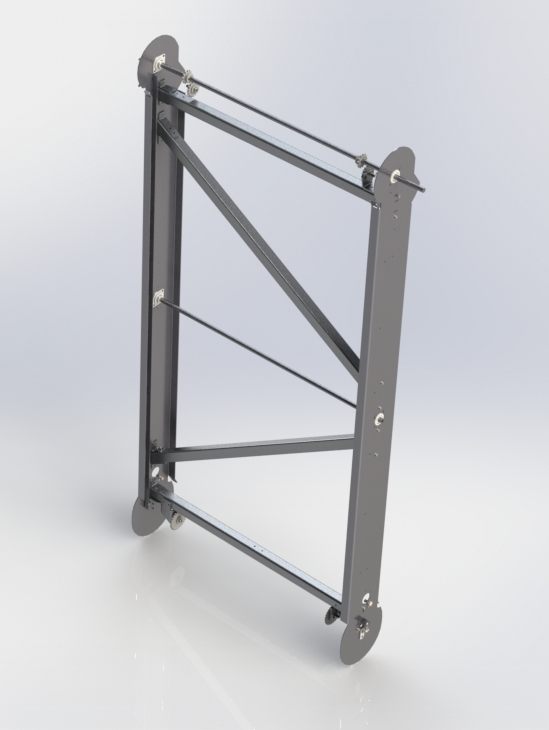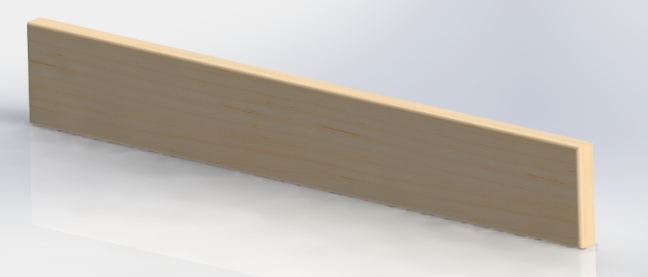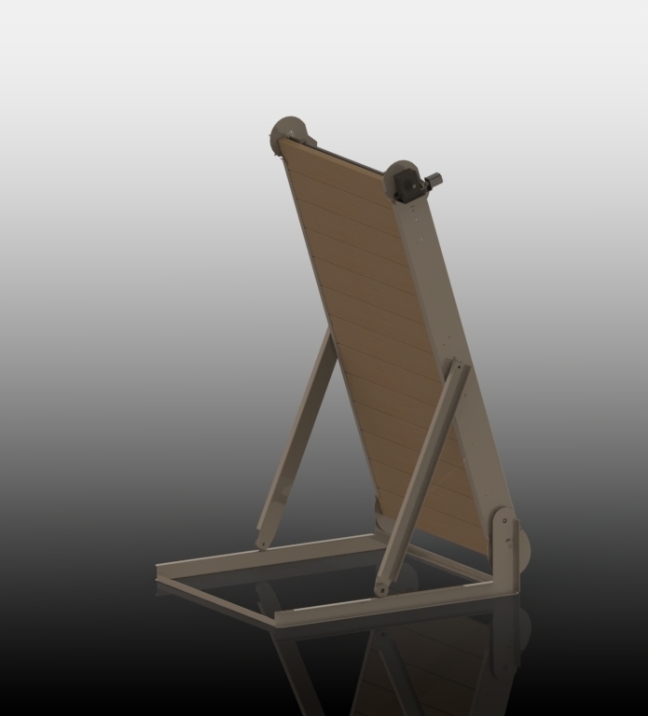You have a Blog? What is this?
For the last couple months I have been playing with a design for a continuous climbing wall. I thought it would be neat to start sharing the design process and then the challenges of building a prototype. If we can make something that works reasonably well and is affordable I might even sell a few (since some friends are already hassling me wanting their own).
What will it look like?
I have a design that I have been refining but I have been working in a vacuum on this. I want to hear any ideas or constructive criticism you might have. My initial idea looks like this:
It consists of a lower frame:
This frame is pretty simple. The wall frame mounts to a hole at the top on each side and the curved plate provides a means of fixing the wall at your desired angle. Braces at the back provide lateral stiffness.
The wall frame:
This is just a couple of formed channels braced with square tubing. The channels, along with an angle, provide a guide for the planks as they move down the wall. The drive shaft is at the top and has sprockets that the drive chains run on. The middle shaft attaches to the lower frame and the wall frame pivots around it. Idler sprockets at the bottom and the top-rear guide the chain.
And a series of wooden planks attached to a standard roller chain:
These are 2x8s. I considered using plywood with a steel stiffener in the back but those would be significantly more expensive. The whole system of planks on a roller chain could be replaced with a heavy rubber belt, which would eliminate finger pinching gaps, but this approach introduces its own challenges and costs. You could also skip the chain by putting hinges between the planks, like a garage door, but it comes out almost as expensive and won’t be as durable.
I considered another layout, shown roughly below, where the wall pivots from the bottom and is braced by two arms on rollers. I like the fact that this would take up a little less space when set vertically, but it means you can’t easily adjust the wall angle by hand. You would also need some support out the back or it would be tippy. Any other alternative ideas?

Since almost everyone I know is either a climber or an engineer I am sure you all might have ideas you could share. Please do so!

Hi Mark. You’ve inspired me to build my own (as I am currently fun-employed and it is COVID). I have begun designing using square tube and off the shelf plates/connection points. I would love to share a couple screenshots with you and get your thoughts before I get too deep into analysis.
Thanks for making this blog – very helpful to follow in your steps (especially as a fellow mechanical-engineer). Looking forward to doing my own FEA.
Best,
Jacob
LikeLike
hey is reading about your project and is really interested in building af climbing wall almost like yours, for a school project. and wanted to hear if you could help me out about maybe if you have some old drawings or inventor drawings, or just about anything will be really helpfull.
LikeLike
Hi Sebastian, In the design I put together the majority of parts are laser cut sheet metal (11ga). Do you have access to a laser or plasma table?
LikeLike
Yes i do, so that wouldent be the problem.
Its more what type of metal and lenght and wide.
Maybe if you have some old inventar drawings you dont use it could be helpful.
LikeLike
I was thinking about making a similar project and was wondering if you would be able to answer some questions I had, specifically about the drive and how the wall moves.
LikeLike
hey landon, I haven’t checked in here in a while. I just responded via email though.
LikeLike
Hey! This project is amazing!
LikeLike